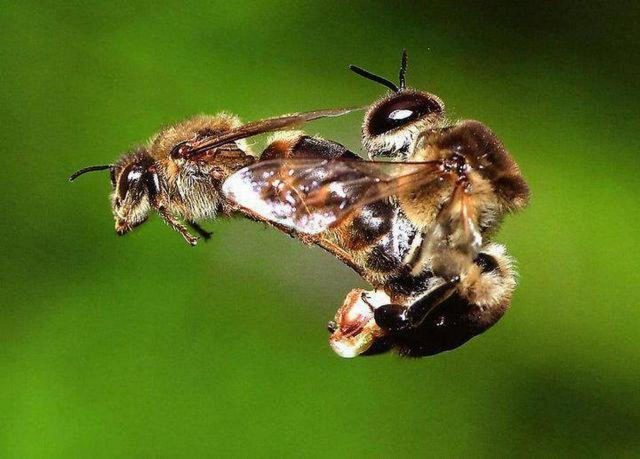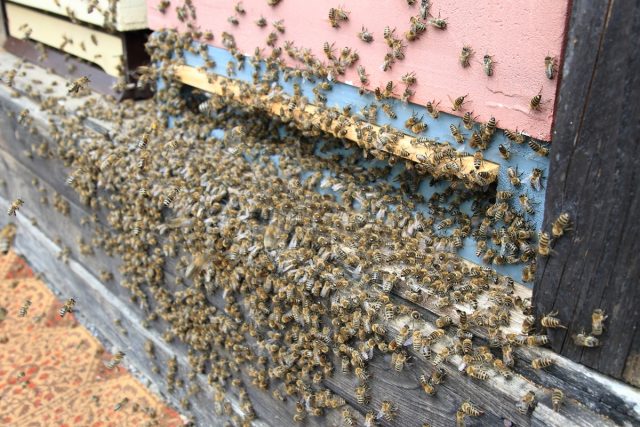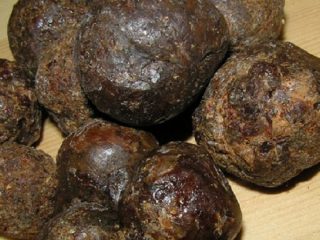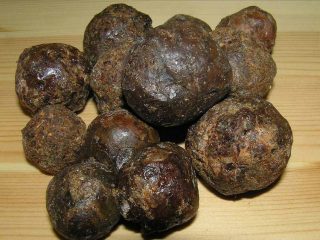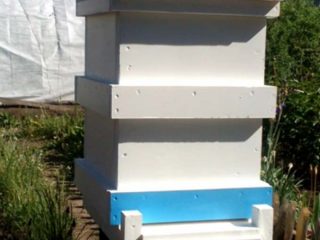Content
Bees reproduce in the wild by swarming. The queen lays eggs, working bees and young females emerge from fertilized eggs, drones are born from unfertilized eggs, their only function is reproduction. Reproduction of bees is the only way to preserve and increase the insect population not only in the apiary, but also in the wild.
Where do bees come from?
Bees create families in which functional loads are strictly distributed between individuals. Within one swarm, 3 types of insects coexist: workers, queen and drones. The duties of the worker bees include collecting honey, caring for the offspring, feeding the female. Drones (males) are responsible for fertilizing the queen. Their only purpose is reproduction. The queen lays eggs and is the backbone of the bee colony, but she is not responsible for raising the offspring.
Bees breed in the wild in a natural way: by mating a female with a drone and swarming... In the latter case, part of the family leaves with the young queen and forms a new family. In apiaries, there is a method of artificial reproduction of families with the participation of a beekeeper. Reproduction is carried out by dividing the family, "plaque on the uterus", layering.
Natural reproduction of honeybee families and other species
One of the methods of reproduction in bees is parthenogenesis, when a full-fledged individual is born from an unfertilized egg. In this way, drones appear in the family with a complete set of genomes characteristic of the species.
How bees mate
Drones and queens reach sexual maturity and reproductive capacity 10 days after leaving the cell. Males fly out of the hive and move approximately 4 km from the swarm. Drones from all families gather in a certain place at a height of 12 m above the ground.
The Queen spends her first introductory flights at the age of three days. The purpose of the flight is to explore the area around the hive. There can be several approximate flights. When it reaches puberty, it is ready to reproduce. In warm weather, it flies out for fertilization. The female bee secretes a secret, to the smell of which the drones react. Mating with representatives of one's own family does not occur. Drones do not react to their "sisters", only to females from another swarm.
Mating in bees takes place in the air, at the time of fertilization, insects fall to the ground, so they do not fly over water and near water bodies. The uterus makes several mating flights lasting 20 minutes. In the process of fertilization of one female, up to 6 drones or more are involved.
Throughout the entire reproduction process, the stinging canal of the uterus remains open. When the paired oviducts are completely filled with the biological material of the drones, it clamps the canal, in the last male the copulatory organ comes off, closing the passage, the drone dies. The arrival of a female in the hive with a white film near the abdomen is a signal that fertilization is complete. After a few hours, the "train" comes off.
Fertilization process:
- The seminal fluid of the male is pushed with force into the eruption channel.
- Following the sperm, a secret is secreted from the accessory glands, which propels the seminal fluid to the exit.
- Sperm is injected into the female's oviducts.
- Part of the liquid flows out, a large mass enters the seminal receptacle.
When the receiver is full, up to 6 million spermatozoa accumulate in it. In bad weather, the Queen's departure is delayed. The female reproductive period lasts about 1 month. If during this period she could not fertilize, then only drones are obtained from the clutch.
Stages of development
The process of fertilization of the egg and mating differ in time. Bee fertilizes eggs at the time of laying, and does this for the entire period of reproductive life. Worming is carried out into empty cells, they are different in size (drone cells are larger). At the time of laying, the female injects seminal fluid from the sperm receptacle onto the egg. An egg laid in a drone cell remains unfertilized. The productivity of the uterus per day is about 2 thousand eggs. Laying begins in February, after insects have overwintered. Under favorable conditions in the hive (+350 C) In spring, brood frames are observed. Maintaining the microclimate in the hive is the function of the workers. Insects do not leave drones for wintering.
In the process of becoming bees, 5 stages are monitored:
- egg (embryonic stage);
- larva;
- prepupa;
- chrysalis;
- imago (a formed adult).
The embryonic stage lasts 3 days, the nucleus is divided inside the egg, in the process of cleavage cells appear that form the wings, trunk and genitals of the insect. The inner shell of the egg is torn, and a larva appears.
Postembryonic development takes place in several stages lasting up to 3 weeks. The larva is equipped with special glands that secrete a secret to form a cocoon. Outwardly, it does not look like an adult insect, immediately after leaving it looks like a rounded fatty body measuring 1.5 mm. The brood feeds on a special substance generated by adult bees. At the age of three days, the size of the larva reaches 6 mm. In 1 week, the initial weight of the brood increases 1.5 thousand times.
During the first day, the brood is fed with milk. The next day, drones and workers are transferred to honey mixed with bee bread, queens are fed only milk until the end of formation. Eggs and larvae are located in open combs. On the 7th day, a cocoon forms around the prepupae, the honeycomb is sealed with wax.
Bee development by day:
Stage | Working bee | Uterus | Drone |
Egg | 3 | 3 | 3 |
Larva | 6 | 5 | 7 |
Prepupa | 3 | 2 | 4 |
Chrysalis | 9 | 6 | 10 |
Total: | 21 | 16 | 24 |
On average, the birth of a bee from egg to imago takes 24 days.
How bees appear
After blocking the cell, the larva creates a cocoon and remains motionless. During this time, all organs of the insect are formed. The pupa outwardly resembles an adult bee. At the end of the formation period, the body of the insect turns dark and becomes covered with pile. The insect has a fully developed flying apparatus, organs of sight and smell. This is a full-fledged bee, which is distinguished from an adult by its size and color tone. The young bee is smaller, the color is lighter. All this time, the kids feed on the bee bread left before the blockage. After complete formation, before birth, the bee gnaws the wax overlap and comes to the surface.
How a queen bee is born
From the moment the eggs are laid, worker bees regulate the emergence of a new queen. A new queen can be born from any fertilized egg, it all depends on the feeding of the brood. If the children are subsequently transferred to honey and bee bread, then the young queens are left unchanged to be fed with royal jelly. After blockage, the honeycomb is filled with milk. Visually, they are larger, there are up to 4 bookmarks for a family.
After formation, the future queen is still in the comb until the feed runs out. Then gnaws through the passage and appears on the surface.Its developmental cycle is shorter than that of drones and worker bees; immediately after birth, the queen destroys rivals that have not yet appeared. There will be only one uterus left in the family. If the beekeeper does not remove the old queen in time, the family becomes swarming.
Swarming as a method of breeding bee colonies
In the wild, swarming is a normal breeding process for bees. In apiaries, they try to prevent this breeding method. The prerequisites for swarming are:
- The appearance of a large number of young bees.
- Cramped room.
- Excess food.
- Poor ventilation.
Young individuals remain idle, the entire functional load is distributed among the old insects. They begin to lay several queen cells. This is a sign of future swarming. The reason for leaving is often the old queen, unable to fully produce the pheromones that the bees are targeting. The faint odor of the uterus is alarming and the need to lay new queen cells.
Young bees left without work begin to accumulate near the entrance. The old uterus is transferred to honey and bee bread, it decreases in weight and size, this is preparatory work before it leaves. The swarm flies 10 days after the egg is placed in the uterine cell. The main composition is young insects. First, scout bees fly around to find a new nest site. After their signal, the swarm rises, flies a short distance and lands.
The bees are at rest for about 1 hour, during which time the queen joins them. As soon as the queen is reunited with the main body, the swarm flies away at a great distance and it will be almost impossible to catch it. In the old hive, 50% of the bees from the former colony remain, among them young individuals are not found. Thus, the process of reproduction of the population in the wild takes place.
How to artificially reproduce bees
In apiaries, beekeepers try to prevent swarming. This method is not suitable for breeding. The process affects the productivity of bees, it is difficult to catch a swarm gone, often insects fly away irrevocably. Therefore, reproduction is carried out artificially: by dividing families, layering, "plaque on the uterus."
Dividing families
The purpose of this breeding method is to make two out of one overcrowded family. Algorithm for reproduction by division:
- Next to the old hive, they put it similar in shape and color.
- 12 frames are placed in it, 8 of them with brood, the rest with bee bread and honey. The frames are transferred when the bees are sitting on them.
- Substitute 4 frames with empty foundation.
- The fetal uterus is implanted. The first 2 days it is kept in a special construction, the behavior of the bees is monitored. If there is no aggression from the worker insects, the uterus is released.
In a new hive, a young female begins laying eggs in empty cells. In another hive, the old and some of the bees will remain. Reproduction in this way has the only drawback, the bees may not accept the new queen.
Layering
This method of reproduction consists in the formation of layers from different families. Before the reproduction of families by this method, a queen bee is taken out or a frame with a queen cell is taken. Create conditions for keeping the future swarm:
- Cook cores.
- The female in the cut must be sterile.
- They take 4 frames from donor, strong families together with the bees, put them in the hive, and shake off the bees from 2 frames there.
- Place 3 frames with food, start the uterus.
This method of reproduction is quite productive, the infertile female will begin laying after fertilization, working individuals will take care of her and the brood.
Method "plaque on the uterus"
This variant of artificial reproduction is carried out if signs of swarming are observed in the hive. Estimated time for breeding is from the second half of May to 15 July. This is the time of active honey collection, the "raid" is carried out in the first half of the day, when most of the insects are on the fly. Family reproduction sequence:
- A hive is prepared, the old one is removed to the side, a new one is put in its place.
- Place frames with honey (about 5 pieces).
- Place 3 frames with foundation.
- The queen is transferred from the old hive to a new one with a brood frame.
Most of the workers will return to their female. In the old beehive, the young growth will be substituted for him with a frame with a mother liquor. Reproduction ends after the appearance of a young female. Busy bees stop swarming.
Conclusion
Bees reproduce in the wild by fertilizing the female and then swarming - this is the natural way. Reproduction by this method in apiary conditions is tried to be avoided. On beekeeping farms, bees are propagated artificially: by dividing the family, by layering, by transplanting a fertile female into a new hive.
